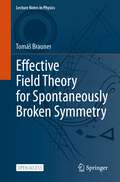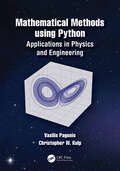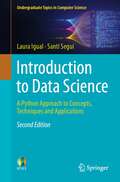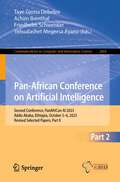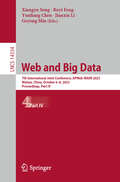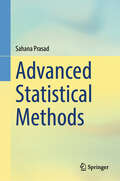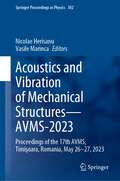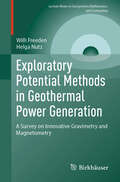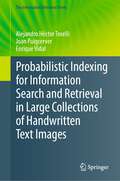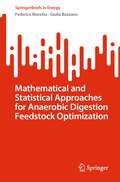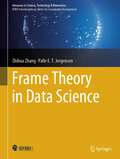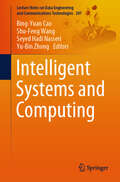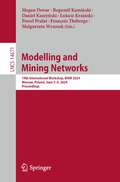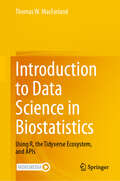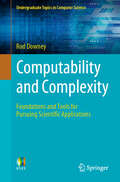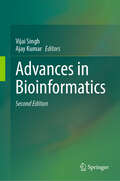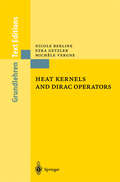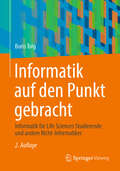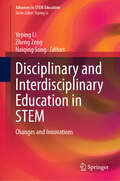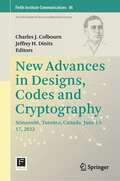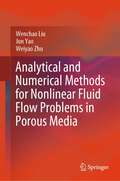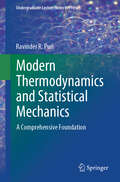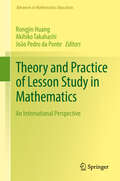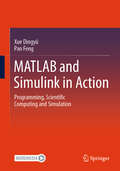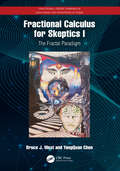- Table View
- List View
Effective Field Theory for Spontaneously Broken Symmetry (Lecture Notes in Physics #1023)
by Tomáš BraunerThis open access book is about spontaneous symmetry breaking, which is a classic area of theoretical physics that lies at the core of many fascinating phenomena such as ferromagnetism, superfluidity, superconductivity, or the Higgs mechanism. The book brings an up-to-date overview of spontaneous symmetry breaking and of modern effective field theory description thereof. The topics covered include the classification of Nambu–Goldstone bosons, nonlinear realization of internal and spacetime symmetries and the construction of the corresponding effective actions, and selected applications. With in-depth exposition of conceptual foundations and numerous illustrative examples, the book is accessible to anybody having taken a basic course on quantum field theory. It serves as a self-contained text for graduate students and junior researchers in diverse areas of physics, but also as a useful reference for experts.
Mathematical Methods using Python: Applications in Physics and Engineering
by Vasilis Pagonis Christopher Wayne KulpThis advanced undergraduate textbook presents a new approach to teaching mathematical methods for scientists and engineers. It provides a practical, pedagogical introduction to utilizing Python in Mathematical and Computational Methods courses. Both analytical and computational examples are integrated from its start. Each chapter concludes with a set of problems designed to help students hone their skills in mathematical techniques, computer programming, and numerical analysis. The book places less emphasis on mathematical proofs, and more emphasis on how to use computers for both symbolic and numerical calculations. It contains 182 extensively documented coding examples, based on topics that students will encounter in their advanced courses in Mechanics, Electronics, Optics, Electromagnetism, Quantum Mechanics etc.An introductory chapter gives students a crash course in Python programming and the most often used libraries (SymPy, NumPy, SciPy, Matplotlib). This is followed by chapters dedicated to differentiation, integration, vectors and multiple integration techniques. The next group of chapters covers complex numbers, matrices, vector analysis and vector spaces. Extensive chapters cover ordinary and partial differential equations, followed by chapters on nonlinear systems and on the analysis of experimental data using linear and nonlinear regression techniques, Fourier transforms, binomial and Gaussian distributions. The book is accompanied by a dedicated GitHub website, which contains all codes from the book in the form of ready to run Jupyter notebooks. A detailed solutions manual is also available for instructors using the textbook in their courses.Key Features:· A unique teaching approach which merges mathematical methods and the Python programming skills which physicists and engineering students need in their courses.· Uses examples and models from physical and engineering systems, to motivate the mathematics being taught.· Students learn to solve scientific problems in three different ways: traditional pen-and-paper methods, using scientific numerical techniques with NumPy and SciPy, and using Symbolic Python (SymPy).Vasilis Pagonis is Professor of Physics Emeritus at McDaniel College, Maryland, USA. His research area is applications of thermally and optically stimulated luminescence. He taught courses in mathematical physics, classical and quantum mechanics, analog and digital electronics and numerous general science courses. Dr. Pagonis’ resume lists more than 200 peer-reviewed publications in international journals. He is currently associate editor of the journal Radiation Measurements. He is co-author with Christopher Kulp of the undergraduate textbook “Classical Mechanics: a computational approach, with examples in Python and Mathematica” (CRC Press, 2020). He has also co-authored four graduate-level textbooks in the field of luminescence dosimetry, and most recently published the book “Luminescence Signal analysis using Python” (Springer, 2022).Christopher Kulp is the John P. Graham Teaching Professor of Physics at Lycoming College. He has been teaching undergraduate physics at all levels for 20 years. Dr. Kulp’s research focuses on modelling complex systems, time series analysis, and machine learning. He has published 30 peer-reviewed papers in international journals, many of which include student co-authors. He is also co-author of the undergraduate textbook “Classical Mechanics: a computational approach, with examples in Python and Mathematica” (CRC Press, 2020).
Introduction to Data Science: A Python Approach to Concepts, Techniques and Applications (Undergraduate Topics in Computer Science)
by Laura Igual Santi SeguíThis accessible and classroom-tested textbook/reference presents an introduction to the fundamentals of the interdisciplinary field of data science. The coverage spans key concepts from statistics, machine/deep learning and responsible data science, useful techniques for network analysis and natural language processing, and practical applications of data science such as recommender systems or sentiment analysis. Topics and features: Provides numerous practical case studies using real-world data throughout the book Supports understanding through hands-on experience of solving data science problems using Python Describes concepts, techniques and tools for statistical analysis, machine learning, graph analysis, natural language processing, deep learning and responsible data scienceReviews a range of applications of data science, including recommender systems and sentiment analysis of text data Provides supplementary code resources and data at an associated website This practically-focused textbook provides an ideal introduction to the field for upper-tier undergraduate and beginning graduate students from computer science, mathematics, statistics, and other technical disciplines. The work is also eminently suitable for professionals on continuous education short courses, and to researchers following self-study courses.
Pan-African Conference on Artificial Intelligence: Second Conference, PanAfriCon AI 2023, Addis Ababa, Ethiopia, October 5–6, 2023, Revised Selected Papers, Part II (Communications in Computer and Information Science #2069)
by Taye Girma Debelee Achim Ibenthal Friedhelm Schwenker Yehualashet Megersa AyanoThis two-volume set, CCIS 2068 and 2069, constitutes selected papers presented during the Second Pan-African Conference on Artificial Intelligence, PanAfriCon AI 2023, held in Addis Ababa, Ethiopia, in October 2023. The set goal of the conference is to exchange the best practices of joint Pan-African efforts to provide solutions for Africa’s key 21st century challenges in the social, economic and ecologic domains. The 29 papers were thoroughly reviewed and selected from 134 submissions. The papers are organized in the following topical sections: Medical AI; Natural Language Processing, Text and Speech Processing; AI in Finance and Cyber Security; Autonomous Vehicles; AI Ethics and Life Sciences.
Web and Big Data: 7th International Joint Conference, APWeb-WAIM 2023, Wuhan, China, October 6–8, 2023, Proceedings, Part IV (Lecture Notes in Computer Science #14334)
by Xiangyu Song Ruyi Feng Yunliang Chen Jianxin Li Geyong MinThe 4-volume set LNCS 14331, 14332, 14333, and 14334 constitutes the refereed proceedings of the 7th International Joint Conference, APWeb-WAIM 2023, which took place in Wuhan, China, in October 2023. The total of 138 papers included in the proceedings were carefully reviewed and selected from 434 submissions. They focus on innovative ideas, original research findings, case study results, and experienced insights in the areas of the World Wide Web and big data, covering Web technologies, database systems, information management, software engineering, knowledge graph, recommend system and big data.
Advanced Statistical Methods
by Sahana PrasadThis is the second book of the two volumes covering the advanced statistical methods and analysis. Significant topics include advanced concepts in regression, index numbers, time series, and vital statistics. The book includes useful examples and exercises as well as relevant case studies for proper implementation of the discussed tools. This book will be a valuable text for advanced undergraduate students of statistics, management, economics, and psychology, wanting to gain advanced understanding of statistics and the usage of its various concepts.
Acoustics and Vibration of Mechanical Structures—AVMS-2023: Proceedings of the 17th AVMS, Timişoara, Romania, May 26–27, 2023 (Springer Proceedings in Physics #302)
by Nicolae Herisanu Vasile MarincaThis book presents peer-reviewed and selected papers from the 17th Conference on Acoustics and Vibration of Mechanical Structures (AVMS) held in Timisoara, Romania, on 26–27 May 2023. Internationally recognized experts share their knowledge and key findings in a broad range of topics related to acoustics and vibration of mechanical structures such as analytical, numerical and experimental techniques for noise and vibration problems, environmental and occupational noise and vibration, modelling, prediction and simulations of noise and vibration, noise and vibration control, noise and vibration attenuators. The book addresses application studies and fundamental studies as well, and it is meant for academics researchers and professionals, as well as Ph.D. students concerned with various fields of acoustics and vibration of mechanical structures.
Exploratory Potential Methods in Geothermal Power Generation: A Survey on Innovative Gravimetry and Magnetometry (Lecture Notes in Geosystems Mathematics and Computing)
by Willi Freeden Helga NutzThe book provides the geoscientific context, that arises in gravimetric/magnetometric exploration. It essentially uses mathematics as a key technology for modeling issues on the basis of analysis and interpretation according to dense and precise gravitational/magnetic measurements. It is dedicated to surface and deep geology with potential data primarily of terrestrial origin. The book spans the interdisciplinary arc from geoengineering, especially geodesy, via geophysics to geomathematics and geology, and back again. It presents the recently published pioneering and groundbreaking multiscale mollifier methodologies realizing the bridging transfer from gravitational/magnetic measurements to approximative/numerical mollifier wavelet decorrelations with novel geologic prospects and layer-structure determination as outcome. Using the specific example of the German Saarland region, new important fields of application, especially for areas with mining-related cavities, will be opened up and subjected to an in-depth geologic detection.
Probabilistic Indexing for Information Search and Retrieval in Large Collections of Handwritten Text Images (The Information Retrieval Series #49)
by Alejandro Héctor Toselli Joan Puigcerver Enrique VidalThis book provides a comprehensive presentation of a recently introduced framework, named "probabilistic indexing" (PrIx), for searching text in large collections of document images and other related applications. It fosters the development of new search engines for effective information retrieval from manuscripts which, however, lack the electronic text (transcripts) that would typically be required for such search and retrieval tasks. The book is structured into 11 chapters and three appendices. The first two chapters briefly outline the necessary fundamentals and state of the art in pattern recognition, statistical decision theory, and handwritten text recognition. Chapter 3 presents approaches for indexing (as opposed to “spotting”) each region of a handwritten text image which is likely to contain a word. Next, Chapter 4 describes models adopted for handwritten text in images, namely hidden Markov models, convolutional and recurrent neural networks and language models, and provides full details of weighted finite-state transducer (WFST) concepts and methods, needed in further chapters of the book. Chapter 5 explains the set of techniques and algorithms developed to generate image probabilistic indexes which allow for fast search and retrieval of textual information in the indexed images. Chapter 6 then presents experimental evaluations of the proposed framework and algorithms on different traditional benchmark datasets and compares them with other approaches, while Chapter 7 reviews the most popular keyword-spotting approaches. Chapter 8 explains how PrIx can support classical free-text search tools, while Chapter 9 presents new methods that use PrIx not only for searching, but also to deal with text analytics and other related natural language processing and information extraction tasks. Chapter 10 shows how the proposed solutions can be used to effectively index very large collections of handwritten document images, before Chapter 11 eventually summarizes the book and suggests promising lines of future research. The appendices detail the necessary mathematical foundations for the work and presents details of the text image collections and datasets used in the experiments throughout the book. This book is written for researchers and (post-)graduate students in pattern recognition and information retrieval. It will also be of interest to people in areas like history, criminology, or psychology who need technical support to evaluate, understand or decode historical or contemporary handwritten text.
Mathematical and Statistical Approaches for Anaerobic Digestion Feedstock Optimization (SpringerBriefs in Energy)
by Federico Moretta Giulia BozzanoThis book examines biomass mixture modeling and optimization. The book discusses anaerobic digestion and related fermentative processes and explains their compositional dynamics. Early chapter examine macromolecules, elemental fractions, and their direct influence on methane production. Supported by an extensive data bank of substrates obtained from research, the book points out correlations that enable the estimation of global methane production for diverse biomass mixtures. Furthermore, it provides valuable insights into discerning the optimal composition capable of yielding the utmost methane output.The book integrates cutting-edge machine learning techniques and shows how the programming language Python and Julia can be used for analysis and to optimize processes. It has many graphs, figures, and visuals.
Frame Theory in Data Science (Advances in Science, Technology & Innovation)
by Zhihua Zhang Palle E. JorgensenThis book establishes brand-new frame theory and technical implementation in data science, with a special focus on spatial-scale feature extraction, network dynamics, object-oriented analysis, data-driven environmental prediction, and climate diagnosis. Given that data science is unanimously recognized as a core driver for achieving Sustainable Development Goals of the United Nations, these frame techniques bring fundamental changes to multi-channel data mining systems and support the development of digital Earth platforms. This book integrates the authors' frame research in the past twenty years and provides cutting-edge techniques and depth for scientists, professionals, and graduate students in data science, applied mathematics, environmental science, and geoscience.
Intelligent Systems and Computing (Lecture Notes on Data Engineering and Communications Technologies #207)
by Bing-Yuan Cao Shu-Feng Wang Seyed Hadi Nasseri Yu-Bin ZhongThis book includes high quality research papers submitted at the 2022 “Four Session (ICFIE, ICORG, GDORS, CGHMORS) Celebration” Joint International Conference held on December 28, 2022 and the online meeting of the Fuzzy Information and Engineering Branch of the China Operations Research Society on September 17, 2022. It covers topics in the fields of certainty, stochastic uncertainty, and fuzzy uncertainty, including computer science and mathematics, operations research and control, artificial intelligence, information and engineering technology, barrier-free communication for people with disabilities, digital logistics and knowledge representation, medical applications, queuing theory and game theory, algorithms and optimization methods. The book is a valuable reference book for scholars, engineers, management professionals, and graduate, undergraduate, and vocational students interested in computer science, mathematics, and fuzzy mathematics and operations research, as well as their applications in information technology and engineering.
Modelling and Mining Networks: 19th International Workshop, WAW 2024, Warsaw, Poland, June 3–6, 2024, Proceedings (Lecture Notes in Computer Science #14671)
by Megan Dewar Bogumił Kamiński Daniel Kaszyński Łukasz Kraiński Paweł Prałat François Théberge Małgorzata WrzosekThis book constitutes the refereed proceedings of the 19th International Workshop on Modelling and Mining Networks, WAW 2024, held in Warsaw, Poland, during June 3–6, 2024. The 12 full papers presented in this book were carefully reviewed and selected from 19 submissions. The aim of this workshop was to further the understanding of networks that arise in theoretical as well as applied domains. The goal was also to stimulate the development of high-performance and scalable algorithms that exploit these networks.
Introduction to Data Science in Biostatistics: Using R, the Tidyverse Ecosystem, and APIs
by Thomas W. MacFarlandIntroduction to Data Science in Biostatistics: Using R, the Tidyverse Ecosystem, and APIs defines and explores the term "data science" and discusses the many professional skills and competencies affiliated with the industry. With data science being a leading indicator of interest in STEM fields, the text also investigates this ongoing growth of demand in these spaces, with the goal of providing readers who are entering the professional world with foundational knowledge of required skills, job trends, and salary expectations. The text provides a historical overview of computing and the field's progression to R as it exists today, including the multitude of packages and functions associated with both Base R and the tidyverse ecosystem. Readers will learn how to use R to work with real data, as well as how to communicate results to external stakeholders. A distinguishing feature of this text is its emphasis on the emerging use of APIs to obtain data.
Computability and Complexity: Foundations and Tools for Pursuing Scientific Applications (Undergraduate Topics in Computer Science)
by Rod DowneyThis is a book about computation, something which is ubiquitous in the modern world. More precisely, it examines computability theory and computational complexity theory. Computability theory is the part of mathematics and computer science which seeks to clarify what we mean by computation or algorithm. When is there a computational solution possible to some question? How can we show that none is possible? How computationally hard is the question we are concerned with? Arguably, this area lead to the development of digital computers. (Computational) complexity theory is an intellectual heir of computability theory. Complexity theory is concerned with understanding what resources are needed for computation, where typically we would measure the resources in terms of time and space. Can we perform some task in a feasible number of steps? Can we perform some algorithm with only a limited memory? Does randomness help? Are there standard approaches to overcoming computational difficulty?
Advances in Bioinformatics
by Vijai Singh Ajay KumarThe second edition of Advances in Bioinformatics presents the latest developments in bioinformatics in gene discovery, genome analysis, genomics, transcriptomics, proteomics, metabolomics, metabolic flux analysis, drug discovery, and drug repurposing. It includes advancements in the applications of bioinformatics in the analysis of non-coding RNA, next-generation sequencing, genome-scale modelling, high throughput drug screening, precision medicine, automation and artificial intelligence, and machine learning. The chapter also summarizes the technologies and concepts that form the basis of this functional genomics approach. Additionally, the book highlights some of the areas in which bioinformatics resources and methods are being developed to support the drug discovery pipeline. The chapter also discusses the role of bioinformatics in modelling and simulations of molecular biology systems in pathways identification and design. It is a valuable source of information for beginners in bioinformatics and students, researchers, scientists, clinicians, practitioners, policymakers, and stakeholders who are interested in harnessing the potential of bioinformatics in biomedical and allied sciences.
Heat Kernels and Dirac Operators (Grundlehren Text Editions)
by Nicole Berline Ezra Getzler Michèle VergneThe first edition of this book presented simple proofs of the Atiyah-Singer Index Theorem for Dirac operators on compact Riemannian manifolds and its generalizations (due to the authors and J.-M. Bismut), using an explicit geometric construction of the heat kernel of a generalized Dirac operator; the new edition makes this popular book available to students and researchers in an attractive softcover. The first four chapters could be used as the text for a graduate course on the applications of linear elliptic operators in differential geometry and the only prerequisites are a familiarity with basic differential geometry. The next four chapters discuss the equivariant index theorem, and include a useful introduction to equivariant differential forms. The last two chapters give a proof, in the spirit of the book, of Bismut's Local Family Index Theorem for Dirac operators.
Informatik auf den Punkt gebracht: Informatik für Life Sciences Studierende und andere Nicht-Informatiker
by Boris TolgDieses Lehrbuch richtet sich an Studierende von fachfremden Studiengängen mit Informatikanteilen. Ein besonderer Schwerpunkt liegt dabei auf den sogenannten Lebenswissenschaften, wie Medizintechnik, Rettungsingenieurwesen, Biotechnologie, Umwelttechnik oder Verfahrenstechnik. Das Lehrbuch eignet sich für Leser in Studium und Praxis, die sich einen Einstieg in die Informatik verschaffen wollen. Die Besonderheit dieses Buches liegt in der problembasierten Herangehensweise, sowie der nach verschiedenen Taxonomiestufen konzipierten Übungsaufgaben.
Disciplinary and Interdisciplinary Education in STEM: Changes and Innovations (Advances in STEM Education)
by Yeping Li Zheng Zeng Naiqing SongThis book provides an international platform for educators from different STEM disciplines to present, discuss, connect, and develop collaborations in two inter-related ways: (1) sharing and discussing changes and innovations in individual discipline-based education in STEM/STEAM, and (2) sharing and discussing the development of interdisciplinary STEM/STEAM education. Possible relationships and connections between individual disciplines (like mathematics or physics) and STEM education remain under explored and the integration of traditionally individual discipline-based education in STEM education is far from balanced. Efforts to pursue possible connections among traditionally separated individual disciplines in STEM are not only necessary for the importance of deepening and expanding interdisciplinary research and education in STEM, but also for the ever-increasing need of reflecting on and changing how traditional school subjects (like mathematics or physics) can and should be viewed, taught, and learned. Scholars from eight countries/regions provide diverse perspectives and approaches on changes and innovations in STEM disciplinary and interdisciplinary education. Disciplinary and Interdisciplinary Education in STEM will be a great resource to students and researchers in STEM education as well as STEM curriculum developers and teacher educators internationally.
New Advances in Designs, Codes and Cryptography: Stinson66, Toronto, Canada, June 13-17, 2022 (Fields Institute Communications #86)
by Charles J. Colbourn Jeffrey H. DinitzThis volume records and disseminates selected papers from the Stinson66 conference, including surveys, prospectives, and papers presenting original and current research. It contains four accessible surveys of topics in combinatorial designs and related topics, ranging from a tutorial survey of connections to classical group theory, to surveys of "hot topics" in current research. It also contains a prospective paper identifying topics for future research efforts, co-authored by one of the elder statesmen of the field, Alex Rosa. Finally, the research papers examine topics ranging from pure mathematics to applied work in computing, networking, communications, and cryptography. For students and newcomers to these topics, the volume provides accessible survey material that does not have onerous prerequisites. The breadth of topics reflects the vibrancy of the field in a way that can be appreciated by all researchers. The papers present important advances on theory and applications,which also benefit advanced researchers.
Analytical and Numerical Methods for Nonlinear Fluid Flow Problems in Porous Media
by Wenchao Liu Jun Yao Weiyao ZhuThis book investigates in detail the mathematical methods and computation methods in efficient solution of some open nonlinear seepage flow problems involved in engineering problems. Developed engineering technologies and some relevant practical field applications are also provided. The introduced open nonlinear problems include nonlinear quadratic pressure gradient term problem, compressible gas seepage flow problem and low-velocity non-Darcy seepage flow problem. Studies on these nonlinear seepage flow problems have attracted engineers and scientists from various disciplines, such as geo-energy engineering, civil and environmental engineering, fluid mechanics, applied mathematics and computation. In particular, the book systematically establishes a fundamental theory for a strongly nonlinear problem of low-velocity non-Darcy seepage flow from a new perspective of moving boundary, while emphasizing the usage of mathematical linearization transformation methods and computational methods into the analytical and numerical solution of the strongly nonlinear partial differential equations. Sufficient knowledge of mathematics is always introduced ahead of model solution to assist readers. And the procedure of strict formula deduction in the model solution process is provided in detail. High-solution figures and tables from model solution are rich in the book. Therefore, it is very helpful for the readers to master the nonlinear model solution methods and engineering technologies. The book is intended for upper undergraduate students and graduate students who are interested in engineering technology, fluid mechanics and applied mathematics, researchers and engineers working on geo-energy science and engineering and field applications.
Modern Thermodynamics and Statistical Mechanics: A Comprehensive Foundation (Undergraduate Lecture Notes in Physics)
by Ravinder R. PuriThis undergraduate-level textbook offers a unique and in-depth approach to the study of thermodynamics and statistical mechanics. It covers the fundamentals of thermodynamics using both traditional and postulatory approaches, including origin of the concept of thermodynamic entropy, Euler’s equation, Gibbs-Duhem relations, stability of equilibrium, and the concept of thermodynamic potentials, and that of independent thermodynamic observables. The book then delves into the microscopic foundation of thermodynamics, starting with the kinetic theory and highlighting its historical development. Boltzmann's concept of entropy is explored, along with its applications in deriving Planck’s, Bose’s, Bose-Einstein, and Fermi-Dirac distribution functions. The formal structure of classical and quantum statistical mechanics is built based on the concept of statistical entropy and the maximum entropy principle and used to investigate in detail the thermodynamic properties of ideal classical and quantum systems. The book also covers phase transitions, simple theory of critical phenomena, and the theory of interacting van der Waals gases. Throughout the text, the book provides historical context, enriching the reader's understanding. This textbook is a valuable resource for undergraduate physics students, offering comprehensive coverage, including overlooked topics, and a historical perspective on thermodynamics and statistical mechanics.
Theory and Practice of Lesson Study in Mathematics: An International Perspective (Advances in Mathematics Education)
by Rongjin Huang Akihiko Takahashi João Pedro da PonteThis book brings together and builds on the current research efforts on adaptation, conceptualization, and theorization of Lesson Study (LS). It synthesizes and illustrates major perspectives for theorizing LS and enriches the conceptualization of LS by interpreting the activity as it is used in Japan and China from historical and cultural perspectives. Presenting the practices and theories of LS with practicing teachers and prospective teachers in more than 10 countries, it enables the reader to take a comparative perspective. Finally, the book presents and discusses studies on key aspects of LS such as lesson planning, post-lesson discussion, guiding theories, connection between research and practice, and upscaling.Lesson Study, which has originated in Asia as a powerful effective professional development model, has spread globally. Although the positive effects of lesson study on teacher learning, student learning, and curriculum reforms have been widely documented,conceptualization of and research on LS have just begun to emerge. This book, including 38 chapters contributed by 90 scholars from 21 countries, presents a truly international collaboration on research on and adaptation of LS, and significantly advances the development of knowledge about this process.Chapter 15: "How Variance and Invariance Can Inform Teachers’ Enactment of Mathematics Lessons" of this book is available open access under a CC BY 4.0 license at link.springer.comTheory and Practice of Lesson Study in Mathematics: An International Perspective shows that the power of Lesson Study to transform the role of teachers in classroom research cannot be explained by a simple replication model. Here we see Lesson Study being successful internationally when its key principles and practices are taken seriously and are adapted to meet local issues and challenges. (Max Stephens, Senior research fellow at TheUniversity of Melbourne)It works. Instruction improves, learning improves. Wide scale? Enduring? Deep impact? Lesson study has it. When something works as well as lesson study does, while alternative systems for improving instruction fail, or only succeed on small scale or evaporate as quickly as they show promise, it is time to understand how and why lesson study works. This volume brings the research on lesson study together from around the world. Here is what we already know and here is the way forward for research and practice informed by research. It is time to wake up and pay attention to what has worked so well, on wide scale for so long.(Phil Dara, A leading author of the Common Core State Standards of Mathematics in the U.S.)
MATLAB and Simulink in Action: Programming, Scientific Computing and Simulation
by Dingyü Xue Feng PanThe textbook is intended for teaching MATLAB language and its applications. The book is composed of three parts: MATLAB programming, scientific computing with MATLAB, and system simulation with Simulink. Since MATLAB is widely used in all fields of science and engineering, a good introduction to the language can not only help students learn how to use it to solve practical problems, but also provide them with the skills to use MATLAB independently in their later courses and research. The three parts of the book are well-balanced and tailored to the needs of engineering students, and the mathematical problems commonly encountered in engineering can be easily solved using MATLAB. This textbook is suitable for undergraduate and graduate students majoring in science and engineering.
Fractional Calculus for Skeptics I: The Fractal Paradigm (Fractional Order Thinking in Exploring the Frontiers of STEM)
by Bruce J. West YangQuan ChenThis book is the first of its kind on fractional calculus (FC), dedicated to advocating for FC in STEM education and research.Fractional calculus is increasingly used today, but there remains a core population of skeptics regarding the utility of this "new" calculus. This book is intended for those who are skeptical about the need for fractional calculus to describe dynamic complex networks and must be convinced of its use on a case-by-case basis. It is a one-stop resource to rapidly read and replace the appropriate skepticism with new knowledge. It offers compelling reasons from the perspectives of the physical, social, and life sciences as to why fractional calculus is needed when addressing the complexity of an underlying STEM phenomenon. The six chapters are accompanied by useful and essential appendices and chapter-end references. Each includes new (fractional-order) ways of thinking about statistics, complexity dynamics, and what constitutes a solution to a complexity science problem.The book will appeal to students and researchers in all STEM-related fields, such as engineering, physics, biology and biomedicine, climate change, big data, and machine learning. It is also suitable for general readers interested in these fields.
